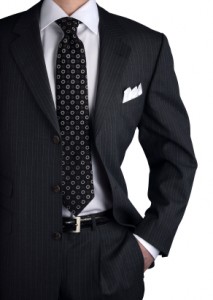 I can vividly remember my first meeting with a new client, back in the spring of 2000. I wore a cobalt blue tie, fastened to a powder blue shirt by a tie tack depicting a Mercury dime. The client wore sweatpants.
I can vividly remember my first meeting with a new client, back in the spring of 2000. I wore a cobalt blue tie, fastened to a powder blue shirt by a tie tack depicting a Mercury dime. The client wore sweatpants.
Having started my web design business in college the year before, at the age of 19, I found out quickly that it could be a challenge to get prospective clients to take me seriously, especially in what was (at the time) an emerging industry dominated by quasi-professionals.
So I compensated by dressing very well whenever I met with anyone to talk business.
Things are a little different now that I’m in my thirties. Nobody asks me how old I am, and my advice and qualifications don’t get questioned nearly as often. But for a business owner, I’m still relatively young. I still have new clients to win over, and my company’s reputation to be mindful of.
Meanwhile, the business world continues to become less formal. Casual attire, in particular, is not only accepted but celebrated—especially in the design industry.
This leads to an important question: As the owner of a design business, how do I dress appropriately for meetings?
I asked myself this question for years, and the answer I eventually came up with can be summarized in the form of one simple rule:
Never be the worst-dressed person in the room.
More often than not, this means being the best-dressed person in the room. If I’m going to stand out, I figure it’s better to stand out in a good way.
The benefits of doing so are clear:
- It sets you apart. Design is something that almost anyone can do. However, if you take your own appearance—your brand—seriously, clients will be more likely to trust you with their brand as well.
- It shows respect for your client and their business culture.
- It can help you make more money. Simply put, it’s easier to justify higher rates if you dress accordingly. (Interestingly enough, I’ve found that charging higher rates alone can lead to more business, because people believe that you get what you pay for.)
- It can prevent embarrassment. It’s far worse to be the only person wearing jeans than it is to be the only person wearing a suit.
If you happen to be overdressed, people will still notice, and you might get a few comments, but it’s unlikely that anyone will mistake you for a lightweight. A year or two ago, I overheard a prospective client referring to me as the “guy in the suit” to one of his co-workers. I didn’t mind, because we were quickly awarded their business.
So what does it mean to dress professionally? It usually depends on the situation. For me, the choice between a polo shirt and a suit (or something in between) is influenced by the following criteria:
- How much money is at stake – A client with a larger budget will most likely have a more formal process for selecting a vendor, and the attire should reflect that. Conversely, a smaller client with a limited budget might assume I’m too expensive if I’m wearing a suit.
- How many other people will be attending – If I’m meeting with three or more people, I usually wear a suit. Bigger meetings tend to be more like presentations or job interviews, rather than informal discussions.
- Familiarity level – When meeting with a longtime client that dresses casually, it’s usually okay to match their attire.
- The nature of the meeting – Sales meetings deserve more formality than, say, brainstorming or planning sessions.
- The image I want to convey – I prefer a more professional look, while many designers go casual to convey creativity and flexibility.
- Age and experience – For about eight years, I was almost always the youngest person in the room. Business attire seemed to make it less noticeable.
- The venue – A brief meeting at Starbucks can be a little more casual than a visit to the client’s office.
Of course, some rules stay the same no matter what. When in doubt, invest in some great shoes, and don’t wear jeans to the first meeting!
